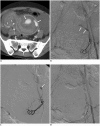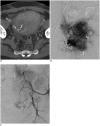Post-operative hemorrhage after myomectomy: safety and efficacy of transcatheter uterine artery embolization
- PMID: 24843240
- PMCID: PMC4023054
- DOI: 10.3348/kjr.2014.15.3.356
Post-operative hemorrhage after myomectomy: safety and efficacy of transcatheter uterine artery embolization
Abstract
Objective: To evaluate the safety and clinical efficacy of transcatheter uterine artery embolization (UAE) for post-myomectomy hemorrhage.
Materials and methods: We identified eight female patients (age ranged from 29 to 51 years and with a median age of 37) in two regional hospitals who suffered from post-myomectomy hemorrhage requiring UAE during the time period from 2004 to 2012. A retrospective review of the patients' clinical data, uterine artery angiographic findings, embolization details, and clinical outcomes was conducted.
Results: The pelvic angiography findings were as follows: hypervascular staining without bleeding focus (n = 5); active contrast extravasation from the uterine artery (n = 2); and pseudoaneurysm in the uterus (n = 1). Gelatin sponge particle was used in bilateral uterine arteries of all eight patients, acting as an empirical or therapeutic embolization agent for the various angiographic findings. N-butyl-2-cyanoacrylate was administered to the target bleeding uterine arteries in the two patients with active contrast extravasation. Technical and clinical success were achieved in all patients (100%) with bleeding cessation and no further related surgical intervention or embolization procedure was required for hemorrhage control. Uterine artery dissection occurred in one patient as a minor complication. Normal menstrual cycles were restored in all patients.
Conclusion: Uterine artery embolization is a safe, minimally invasive, and effective management option for controlling post-myomectomy hemorrhage without the need for hysterectomy.
Keywords: Digital subtraction angiography; Uterine artery embolization; Uterine myoma; Uterine myomectomy.
Figures


Similar articles
-
Analysis of presurgical uterine artery embolization (PUAE) for very large uterus myomatosus; patient's desire to preserve the uterus; case series and literature review.Rofo. 2018 Jul;190(7):616-622. doi: 10.1055/s-0044-101555. Epub 2018 Mar 7. Rofo. 2018. PMID: 29514385 English, German.
-
Pre-operative uterine artery embolization before hysterectomy or myomectomy: a single-center review of 53 patients.Clin Imaging. 2023 Sep;101:121-125. doi: 10.1016/j.clinimag.2023.06.003. Epub 2023 Jun 9. Clin Imaging. 2023. PMID: 37329639
-
[Uterine artery embolization for myomas treatment].Presse Med. 2013 Jul-Aug;42(7-8):1127-32. doi: 10.1016/j.lpm.2013.02.322. Epub 2013 Apr 18. Presse Med. 2013. PMID: 23602353 French.
-
[Role of embolization in the management of uterine fibroids].J Gynecol Obstet Biol Reprod (Paris). 2011 Dec;40(8):918-27. doi: 10.1016/j.jgyn.2011.09.030. Epub 2011 Nov 16. J Gynecol Obstet Biol Reprod (Paris). 2011. PMID: 22093440 Review. French.
-
Surgical treatment of fibroids in heavy menstrual bleeding.Womens Health (Lond). 2016 Jan;12(1):53-62. doi: 10.2217/whe.15.89. Epub 2015 Dec 23. Womens Health (Lond). 2016. PMID: 26693796 Free PMC article. Review.
Cited by
-
Anatomic variations of the Uterine Artery. Review of the literature and their clinical significance.Turk J Obstet Gynecol. 2020 Mar;17(1):58-62. doi: 10.4274/tjod.galenos.2020.33427. Epub 2020 Apr 6. Turk J Obstet Gynecol. 2020. PMID: 32341832 Free PMC article. Review.
-
Management of post-cesarean uterine artery pseudoaneurysm in Indonesia.J Vasc Surg Cases Innov Tech. 2025 May 23;11(4):101856. doi: 10.1016/j.jvscit.2025.101856. eCollection 2025 Aug. J Vasc Surg Cases Innov Tech. 2025. PMID: 40787602 Free PMC article.
-
Embryology of the Vascular System: Implications for Variants.Semin Intervent Radiol. 2025 Feb 20;42(2):219-228. doi: 10.1055/s-0045-1802308. eCollection 2025 Apr. Semin Intervent Radiol. 2025. PMID: 40376214 Review.
-
A Case Report of a Patient with Spontaneously Resolving Unruptured Uterine Artery Pseudoaneurysm after Surgery for Miscarriage during the Early Stages of Pregnancy Using Manual Vacuum Aspiration.Gynecol Minim Invasive Ther. 2022 Feb 14;11(1):54-56. doi: 10.4103/GMIT.GMIT_33_20. eCollection 2022 Jan-Mar. Gynecol Minim Invasive Ther. 2022. PMID: 35310125 Free PMC article.
-
A comparative study on the effects of MRI- and CT-guided interventional therapies on uterine fibroids.Pak J Med Sci. 2016 Sep-Oct;32(5):1082-1086. doi: 10.12669/pjms.325.10234. Pak J Med Sci. 2016. PMID: 27881998 Free PMC article.
References
-
- Falcone T, Parker WH. Surgical management of leiomyomas for fertility or uterine preservation. Obstet Gynecol. 2013;121:856–868. - PubMed
-
- Luciano AA. Myomectomy. Clin Obstet Gynecol. 2009;52:362–371. - PubMed
-
- Lefebvre G, Vilos G, Allaire C, Jeffrey J, Arneja J, Birch C, et al. The management of uterine leiomyomas. J Obstet Gynaecol Can. 2003;25:396–418. quiz 419-422. - PubMed
-
- Kongnyuy EJ, Wiysonge CS. Interventions to reduce haemorrhage during myomectomy for fibroids. Cochrane Database Syst Rev. 2011;(11):CD005355. - PubMed
-
- Lotterman S. Massive hemoperitoneum resulting from spontaneous rupture of uterine leiomyoma. Am J Emerg Med. 2008;26:974.e1–974.e2. - PubMed
Publication types
MeSH terms
LinkOut - more resources
Full Text Sources
Other Literature Sources
Medical

